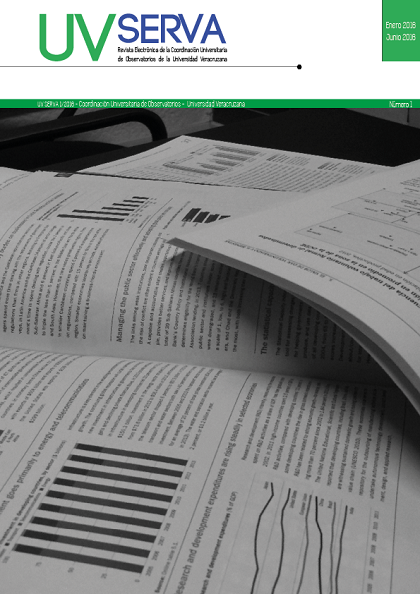Resumo
La misión del Observatorio Sismológico y Vulcanológico (OSV) del Centro de Ciencias de la Tierra de la Universidad Veracruzana (CCTUV) es contribuir a la Protección Civil en el estado de Veracruz mediante el estudio sistemático de la sismicidad y vulcanismo activo de esta entidad a través de su monitoreo permanente, evaluando el impacto en su entorno e identificando oportunamente el peligro asociado con la finalidad de informar a los encargados de generar las medidas preventivas, tomadores de decisiones y a la sociedad en general. El OSV también colabora en el desarrollo de investigación básica y aplicada, la implementación de metodologías y tecnologías de vanguardia, generación de productos académicos de valor científico, y el apoyo en procesos orientados a la comprensión de estos fenómenos geofísicos.
Abstract: The mission of the Seismological and Volcanological Observatory (OSV) at the
Center of Earth Sciences of the Universidad Veracruzana (CCTUV) is to contribute to the
Civil Protection in the state of Veracruz through the systematic study of seismicity and active volcanism of this entity by the means of constant monitoring, evaluating the impact on the environment and identifying associated hazard with the purpose of informing the responsible entities for generating preventive measures, decision makers and society in general. The OSV is also working on the development of basic and applied research, implementation of methodologies and cutting-edge technologies, generation of academic products of scientific value, and support measures aimed at understanding these geophysical phenomena.
Keywords: Observatory; university; seismicity; volcanism.
Referências
Carrasco-Núñez, G., 1991. Lava flow growth inferred from morphometric parameters: a
case study of Citlaltépetl volcano, Mexico. En: Geol. Magazine 134, 2, 151-162.
Carrasco-Núñez, 1993 Tesis, Structure, eruptive history, and some major hazardous events
of Citlaltépetl volcano (Pico de Orizaba), México. En: Michigan Technological University.
PhD thesis, pp. 181.
Carrasco-Núñez, G. y Ban, M., 1994. Geologic map and structure sections of the Summit
area of Citlaltépetl volcano, Mexico. Serie de cartas geológicas y mineras no 9, Inst. de
Geología, UNAM, México.
Carrasco-Núñez, G., 1999. Holocene block-and-ash flows from summit dome activity of
Citlaltépetl volcano, Eastern Mexico. JVGR, 88, 47-66.
Concha-Dimas A., Cerca M., Rodríguez S., Watters R., 2005. Geomorphological evidence
of the influence of pre-volcanic basement structure on emplacement and deformation of
volcanic edifices at the Cofre de Perote-Pico de Orizaba chain and implications for
avalanche generation. Geomorphology, 72, 19–39.
Crausaz, W., 1994. Pico de Orizaba o Citlaltépetl: Geology, archaeology, history, natural
history and mountaineering routes. Geopress International, Ohio, USA.
Ferrari, L., Orozco-Esquivel, T., Manea, V., Manea, M., 2012. The dynamic history of the
Trans-Mexican Volcanic Belt and the Mexico subduction zone. Tectonophysics, 522-523,
-149.
Hoeskuldsson, A., 1992. Le complexe volcanique Pico de Orizaba-Sierra Negra-Cerro de
las cumbres (sud-est mexicain); Structure, Dymamismes eruptifs et evolutions del area:
Clermont-Ferrand, Francia. En: Université Blaise Pascal. Tesis Doctoral, pp. 220.
Hoskuldsson, A., Robin, C, Cantagrel, J.M., 1990. Repetitive debris avalanche events at
volcano Pico de Orizaba, Mexico. IAVEI International Volcanological Congress, Mainz
(abstract), 47.
Koyanagi, R.Y., 1968. Hawaiian seismic events during 1965: U.S. Geol. Survey Prof.
Paper 600-B, p. 95-98.
Malone, S.D., 1983. Volcanic earthquakes: examples from Mount St. Helens, En: Earthquakes: Observation, Theory and Interpretation, LXXXV Corso, Soc. Italiana di Fisica,
Bologna, Italy, P. 436-455.
Minakami T., 1994. Seismology of volcanoes in Japan, in Physical volcanology, edited by
L. Civetta, P. Gasparini, G. Luongo, and A. Rapolla, Elsevier Scientific Publishing
Company, pp. 1-27, Amsterdam, The Netherlands.
Mooser F., Meyer-Abich H., McBimey A.R., 1958. Catalogue of the active volcanoes of
the world including solftara fields. Part VI Central America. En: Napoli International
Volcanology Asociation. pp 1-3.
Moziño J.M., 1870. Informe sobre la erupción del Volcán de San Martín Tuxtla (Veracruz)
ocurrida el año de 1793. Boletín Soc. Mex. Geograf. Estad. II: 62-72.
Nelson, S.A. y González-Caver, E., 1992. Geology and K-Ar dating of the Tuxtla
Volcanic Field, Veracruz, Mexico. Bull. Volcanol., v. 55, p. 85-96.
Nelson, S.A., González-Caver, E., Kyser, T.K. (1995): Constraints on the origin of alkaline
and calc-alkaline magmas from the Tuxtla Volcanic Field, Veracruz, Mexico. Contrib.
Mineral. Petrol., v. 122, p. 191-211.
Robin C. y Cantagrel J.M., 1982. Le Pico de Orizaba (Mexique): Structure et evolution
d’un gran volcán andésitique complex. En: Bolletin of Vulcanology. pp 45, 299-315.
Siebert y Carrasco-Núñez, 2002. Late Pleistocene to precolumbian behind-the-arc mafic
volcanism in the Eastern Mexican Volcanic Belt; implication for future hazards. J.
Volcanol. Geotherm. Res., 115, 179-205.
Singh, S.K., Wyss, M. (1976), Source parameters of the Orizaba earthquake of August 28,
, Geofis. lnt. 16, 165-184.
Tilling, R.I., ed., 1989. Volcanics hazards: Washington. D.C., American Geophysical
Union, Short Course in Geology, v. 1, 123 p.
Waitz P., 1910. Observaciones geológicas acerca del Pico de Orizaba. En: Boletín de la
Sociedad Geologíca Mexicana. Tomo VII., pp 67.


